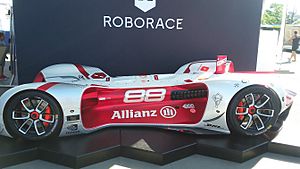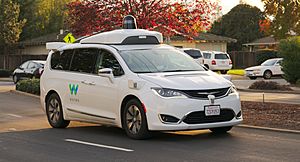Driverless car facts for kids
A self-driving car, also called an autonomous car or driver-less car, is a vehicle that can drive itself without a human driver. These cars use many special tools called sensors to "see" their surroundings. These sensors include cameras, radar (like bats use sound), lidar (which uses light), ultrasound, and GPS.
A computer system in the car takes all this information from the sensors. It then builds a 3D picture of everything around the car. Based on this picture, the car figures out the best way to drive, how to handle traffic lights and stop signs, and how to avoid obstacles like other cars or people.
PC Magazine describes a self-driving car as "a computer-controlled car that drives itself." The Union of Concerned Scientists says they are "cars or trucks in which human drivers are never required to take control to safely operate the vehicle."
Contents
What are Self-Driving Cars?
Self-driving cars are vehicles that can operate on their own. They don't need a person to steer, accelerate, or brake. They use advanced technology to understand their environment and make driving decisions.
How Do Self-Driving Cars Work?
These cars are packed with technology! They use:
- Cameras: To see traffic signs, lane markings, and other vehicles.
- Radar: To detect how far away other objects are.
- Lidar: To create detailed 3D maps of the surroundings using laser light.
- GPS: To know the car's exact location on a map.
- Computers: To process all this information and decide what to do next.
All these parts work together like a super-smart brain. They help the car navigate, avoid crashes, and follow traffic rules.
A Quick Look at History
People have been dreaming about self-driving cars for a long time! Experiments with automated driving started way back in the 1920s. More serious tests began in the 1950s.
The first car that could drive itself a little bit was made in Japan in 1977. It needed special marked roads and used cameras to follow them. It could go up to 30 kilometers per hour (about 18 miles per hour).
In the 1980s, a very important self-driving car was created. Today, big car companies like Honda, Tesla, and Mercedes-Benz are all working on new self-driving models. By 2021, these cars were already being used in controlled places, like buses moving passengers between airport terminals.
Different Levels of Self-Driving Cars
Not all self-driving cars are the same. Experts have created six levels to describe how much a car can drive itself. This system was developed by an organization called SAE International.
- Level 0: No automation. The human driver does everything.
- Level 1: Driver assistance. The car can help with one thing, like steering or speeding up. The driver must still pay attention.
- Level 2: Partial automation. The car can help with two things at once, like steering and keeping speed. The driver still needs to be ready to take over.
- Level 3: Conditional automation. The car can drive itself in certain situations, but the driver must be ready to take over if the car asks.
- Level 4: High automation. The car can drive itself in most situations without human help. It can even handle tricky parts of the journey.
- Level 5: Full automation. The car can drive itself everywhere, in all conditions, just like a human driver. You don't even need a steering wheel!
How Self-Driving Cars Can Be Used
Self-driving technology can be used in many different ways:
Robotaxis
Imagine calling a taxi, and no one is driving it! That's a robotaxi. These are meant to be used by taxi or ride-sharing companies. Many big technology companies have invested a lot of money into developing robotaxis, especially in the U.S.
Self-Driving Shuttles and Buses
These vehicles are often used in cities. For example, in Europe, projects like "CityMobil2" and "Avenue" have helped develop self-driving shuttles. They have been tested in cities like Geneva, Lyon, and Copenhagen.
Self-Driving Trucks and Vans
Companies like Otto and Starsky Robotics have worked on self-driving trucks. These trucks could make roads safer and save fuel by driving close together in groups called "platoons." Self-driving vans are also being developed for delivering groceries and other goods.
Autonomous Micro-Mobility
This means small, lightweight self-driving vehicles. They could help deliver goods in cities more efficiently. Some studies even suggest they could help reduce the number of cars on our roads. Honda has shown off its "Honda CI Micro-mobility" machines, which are small self-driving vehicles being tested in Japan.
Autonomous Work Vehicles
These are self-driving machines designed for specific jobs, like at construction sites or factories. For example, Honda and Black & Veatch tested an Autonomous Work Vehicle (AWV) at a construction site in New Mexico. In Japan, a company called eve autonomy has launched a commercial service using self-driving work vehicles in factories and refineries.
Benefits of Self-Driving Cars
Self-driving cars offer many exciting advantages:
- Safer Roads: These cars could help reduce accidents because they don't get tired or distracted like human drivers.
- More Freedom: People who can't drive, like those with disabilities or older adults, could use self-driving taxis to get around easily.
- Efficient Transport: Self-driving trucks could travel for longer periods without needing breaks, making deliveries faster and more efficient.
- Better Cities: In the future, self-driving cars might change how cities are planned, making traffic smoother and reducing parking needs.
Things to Think About
While self-driving cars have many benefits, there are also some important things to consider:
- Safety in Tricky Situations: How will a self-driving car decide what to do in a dangerous situation, especially if it has to choose between two bad options?
- Jobs: What will happen to people who work as drivers if self-driving vehicles become common?
- Understanding Humans: Will the car's computer be able to understand gestures or spoken instructions from police officers or pedestrians?
- Cyberattacks: Could hackers try to take control of self-driving cars?
- Privacy: Self-driving cars collect a lot of data about where you go and what you do. How will this information be kept private?
- Road Upgrades: Our roads might need to be changed to work best with self-driving cars. New rules and laws will also be needed.
The Trolley Problem for Cars
This is a famous thought experiment that engineers face when programming self-driving cars. Imagine a self-driving car is driving, and suddenly a person appears in its path. The car has two choices:
- Hit the person.
- Swerve into a wall, which would hurt or even kill the passengers inside the car.
Which choice should the car make? It's a very difficult question! Studies show that people generally agree that self-driving cars should be programmed to cause the least harm. However, when people think about buying a self-driving car for themselves, they often want the car to protect the people inside at all costs. This shows how complex these decisions are.
What People Think About Self-Driving Cars
Surveys have shown different opinions about self-driving cars:
- In 2011, a survey found that almost half (49%) of people in the U.S. and UK would feel comfortable using a driverless car.
- In 2019, some surveys showed that people were less comfortable with cars that had very high levels of automation. They also thought that cars with partial self-driving features still needed a lot of human attention.
- A 2022 study found that only about a quarter (27%) of people worldwide would feel safe in self-driving cars.
Waymo: A Pioneer in Self-Driving
Waymo started as a self-driving car project within Google. By 2012, their test cars had driven over 500,000 kilometers (about 300,000 miles) without accidents. They even started testing with just one person in the car instead of two.
In 2014, Google showed off a new prototype that didn't even have a steering wheel or pedals! It was fully automated. By 2016, their test cars had driven a total of 1.5 million miles (about 2.4 million kilometers) in self-driving mode.
In December 2016, Google created a new company called Waymo just for its self-driving technology. Both Google and Waymo are now part of a bigger company called Alphabet.
Early reports from Google showed that their test cars were involved in 14 crashes, but in 13 of those, another driver was at fault. However, in 2016, the car's own software did cause one crash.
Images for kids
-
A Waymo self-driving car prototype driving in Mountain View, California in 2017.
See also
 In Spanish: Vehículo autónomo para niños
In Spanish: Vehículo autónomo para niños







